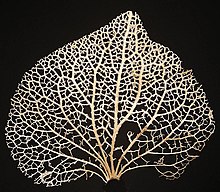Anastomosis

An anastomosis (plural anastomoses, from gr. ἀναστόμωσις, communicating opening) is the reconnection of two streams that previously branched out, such as blood vessels or leaf veins. The term is used in medicine, biology, mycology, geology and architecture.
Medicine

Anastomosis is the connection of two structures.[1] It refers to connections between blood vessels or between other tubular structures such as loops of intestine. In circulatory anastomoses, many arteries naturally anastomose with each other, for example the inferior epigastric artery and superior epigastric artery.The circulatory anastomosis is further divided into arterial and venous anastomosis. Arterial anastomosis includes actual arterial anastomosis (e.g. palmar arch, plantar arch) and potential arterial anastomosis (e.g. coronary arteries and cortical branch of cerebral arteries). An example of surgical anastomosis occurs when a segment of intestine is resected and the two remaining ends are sewn or stapled together (anastomosed), for example Roux-en-Y anastomosis. The procedure is referred to as intestinal anastomosis.
Pathological anastomosis results from trauma or disease and may involve veins, arteries, or intestines. These are usually referred to as fistulas. In the cases of veins or arteries, traumatic fistulas usually occur between artery and vein. Traumatic intestinal fistulas usually occur between two loops of intestine (entero-enteric fistula) or intestine and skin (enterocutaneous fistula). Portacaval anastomosis, by contrast, is an anastomosis between a vein of the portal circulation and a vein of the systemic circulation, which allows blood to bypass the liver in patients with portal hypertension, often resulting in hemorrhoids, esophageal varices, or caput medusae.
Biology
Evolution
In evolution, anastomosis is a recombination of evolutionary lineage. Conventional accounts of evolutionary lineage present themselves as the simple branching out of species into novel forms. Under anastomosis, species might recombine after initial branching out, such as in the case of recent research which shows that ancestral populations along human and chimpanzee lineages may have interbred after an initial branching event.[2] The concept of anastomosis also applies to the theory of symbiogenesis, in which new species emerge from the formation of novel symbiotic relationships.
Mycology
In mycology, anastomosis is the fusion between branches of the same or different hyphae.[3] Hence the bifurcating fungal hyphae can form true reticulating networks. By sharing materials in the form of dissolved ions, hormones, and nucleotides, the fungus maintains bidirectional communication with itself. The fungal network might begin from several origins; several spores (i.e. by means of conidial anastomosis tubes), several points of penetration, each a spreading circumference of absorption and assimilation. Once encountering the tip of another expanding, exploring self, the tips press against each other in pheromonal recognition or by an unknown recognition system, fusing to form a genetic singular that can cover hectares called a genet or just microscopical areas.[4]
For fungi, anastomosis is also a component of sex. In some fungi, two different haploid mating types — if compatible — merge. Somatically, they form a morphologically similar mycelial wave front that continues to grow and explore. The significant difference, is that in each septated unit is binucleate, containing two unfused nuclei, i.e. one from each parent that will eventually undergo karyogamy and meiosis to complete the sexual cycle.
Geology
In geology, anastomosis refers to quartz (or other) veins displaying this property, which is often related to shearing in metamorphic regions.
Anastomosing streams are a type of organic-rich anabranching river that consist of multiple channels that divide and reconnect and are separated by such cohesive material that they would likely not be able to migrate from one channel position to another. Rivers with anastomosed reaches include the Magdalena River in Colombia,[5] the upper Columbia River in British Columbia, Canada,[6] and the upper Narew River in Poland.[7]
References
- ^ Gylys, Barbara A. and Mary Ellen Wedding (2005), Medical Terminology Systems, F.A. Davis Company
- ^ Patterson, Nick (2006). "Genetic evidence for complex speciation of humans and chimpanzees". Nature. 441 (7097): 1103–1108. doi:10.1038/nature04789. PMID 16710306. Retrieved 2006-09-18.
{{cite journal}}: Unknown parameter|coauthors=ignored (|author=suggested) (help); Unknown parameter|month=ignored (help) - ^ Kendrick, Bryce (2001), The Fifth Kingdom, Mycologue Publications
- ^ Glass, L.; Rasmussen, C.; Roca, M.G.; Read, N. (2004). Hyphal homing, fusion and mycelial interconnectedness. TRENDS in Microbiology 12: 135–141.
- ^ Smith, D (1986). "Anastomosing river deposits, sedimentation rates and basin subsidence, Magdalena River, northwestern Colombia, South America". Sedimentary Geology. 46 (3–4): 177. doi:10.1016/0037-0738(86)90058-8.
- ^ Abbado, D., Slingerland, R.L., and Smith, N.D., 2005, The origin of anastomosis in the upper Columbia River, British Columbia, Canada: In Blum, M.D., Marriott, S., and Leclair. S. (eds.), Fluvial Sedimentology VII, Internat. Assoc. Sedim. Special Publ. 35.
- ^ Gradzinski, R (2003). "Vegetation-controlled modern anastomosing system of the upper Narew River (NE Poland) and its sediments". Sedimentary Geology. 157 (3–4): 253. doi:10.1016/S0037-0738(02)00236-1.
External links
- Official web page [anastomosis] the connected city
